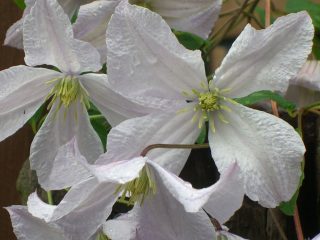Content
Clematis Solidarity is a relatively young hybrid of Polish selection. The decorativeness of the bush and the original coloring of the flowers earned a silver medal at the Plantarium exhibition in Holland in 2005. The flowering plant is a climbing representative of the flora and is widely used in landscape design for vertical gardening.
Description of clematis Solidarity
According to the description, clematis Solidarity (pictured) is a perennial liana-like plant with woody main stems and flexible, strong shoots. During the growing season, clematis Solidarity grows up to 1.5 meters. The variety belongs to the subshrubs and requires the installation of a structure supporting the vine. As the plant grows, it is secured to its support with the help of leaf petioles. The hybrid does not grow very quickly; it produces many young shoots with soft green foliage. When it reaches adulthood (5 years), full flowering begins.
Clematis Solidarity is a large-flowered hybrid that produces flowers from May to the end of September. The duration of flowering depends on the characteristics of the regional climate. In the South it is longer, in central Russia it is shorter. Clematis Solidarity blooms continuously, the first flowers appear on the shoots of the second year, then form on young stems. Flowering is abundant, the bush is completely covered with a continuous burgundy carpet.
Clematis Solidarity is one of the most popular varieties. Plant frost resistance is a necessary quality for temperate climates. Drought resistance is a priority in the South. Solidarity is being cultivated throughout almost all of Russia.
External characteristics:
- Clematis bush Solidarity is compact, densely leafy, the leaf blade is light green, smooth with pronounced veins, reticulate. The leaves are lanceolate, opposite, medium-sized, trifoliate.
- The root system is of a mixed type, widely grown, going down to 2 m.
- The plant is dioecious, the flowers are large - 18 cm in diameter, consist of 6 sepals, oblong, oval in shape, tapering towards the apex. The velvety surface is a bright burgundy color, in the center there is an oblong ribbing of a light tone and minor white inclusions. The edges of the petals are smooth.
- The dark purple anthers are on long, thin, light yellow filaments arranged in a semicircle.
Clematis Solidarity is used for decorative design of areas in mass plantings with varieties of various (white, pink, blue, light blue) flower colors. Used to form arches, hedges, walls defining garden areas, and for vertical gardening of gazebos.
Clematis pruning group Solidarity
Clematis (caper) Solidarity is a large-flowered variety belonging to the second (weak) pruning group. Varieties of this variety rarely grow above 1.7 m. The peculiarity of the crop is that the main flowering occurs on perennial shoots. Therefore, they are not cut, but removed from the structure and covered for the winter. If the stems are cut, clematis Solidarity will not bloom on new season shoots. At best, it will be a single bud on the lower part of the bush.
The second group includes most of the varieties of hybrid clematis. Growing the Solidarity variety requires certain knowledge of agricultural technology:
- it is necessary to maintain the integrity of the lashes when they are removed from the support, the vine is quite fragile;
- a plant that is not properly covered for the winter may not preserve its buds, and increased humidity will cause the stems near the roots to rot;
- the inside of the bush is a comfortable place for wintering small rodents; in the spring, 1/3 of the plant may remain, the remaining branches will be damaged by mice.
The appearance of multiple buds completely compensates for the inconvenience during care. The original ornamental plant will stand out among other varieties due to the beauty of the bush and continuous abundant flowering.
Conditions for growing clematis Solidarity
Cover crops, which include the hybrid clematis Solidarity, grow in height until they reach adulthood. Then they only strengthen the bush with side shoots. The length of perennial vines remains unchanged.
Install the trellis in such a way as to remove the stems with minimal losses. Clematis Solidarity is not suitable for decorating the walls of buildings. The close location of the building will raise the air temperature in summer, making it difficult to remove from the support.Clematis needs a well-ventilated place, but without a sharp north wind.
Planting and caring for clematis Solidarity
Clematis varieties of the second pruning group grow more slowly than representatives of other groups. They need a lot of light to grow. The root circle should be free of any plants. The composition of the soil is slightly acidic or neutral, fertile, loose. The soil is sandy loam or loamy with abundant humus. The soil should not be dry or waterlogged.
Selection and preparation of a landing site
The site for clematis Solidarity is determined taking into account that the root system is in the shade, the stems and young shoots are in open space. For photosynthesis, the plant needs excess ultraviolet light. Not the least role for clematis Solidarity is played by the composition of the soil and the size of the hole.
Planting holes are prepared 10 days before planting the crop. The hole should be deep enough, approximately 75 cm, the width is determined by the root system of the seedling, the distance to the edge should be at least 20 cm. A drainage layer is placed at the bottom. Prepare the nutritional mixture:
- sand – 3 kg;
- peat – 3 kg;
- compost – 5 kg;
- ash – 200 g;
- superphosphate – 100 g;
- nitrophoska – 200 g.
Seedling preparation
Clematis seedlings Solidarity, prepared independently, are stored in a dark room in winter at +1-3 0C, after the buds appear, the planting material is taken to a well-lit place. Before planting, they are removed from the soil where the cuttings sprouted, the root is placed in an antifungal solution, then in a growth-stimulating preparation.
When dividing a bush, take into account the following rules:
- divide the plant at least 5 years old;
- planting is carried out before the main sap flow;
- each plot should be equipped with a healthy root system and five full buds.
If the seedling is purchased from a nursery, check the condition of the root and the presence of healthy shoots. Disinfection and stimulation are carried out if the seedling has not been subjected to the procedure before sale.
Landing rules
When mass planting clematis Solidarity, leave 70 cm between holes. Sequence of actions:
- A seedling is placed in the center and the roots are distributed along the bottom.
- Add the rest of the nutrient mixture.
- Deepen the root collar by 7-9 cm.
- The root circle is compacted and watered with organic matter.
Watering and fertilizing
A prerequisite is that when watering, you must not allow the soil to become waterlogged or the top layer to dry out. An adult plant is watered with a large volume of water 2 times a month. Young seedlings are watered regularly, focusing on the amount of precipitation. The root circle must be moist, the soil loose, and the presence of weeds is strictly prohibited.
Large-flowered varieties of the second pruning group require constant feeding. Clematis Solidarity is fertilized:
- in early May - urea;
- during budding - “Agricola-7”;
- after flowering - organic matter;
- in the fall - superphosphate, potassium-containing products.
During the formation of flowers, plants are treated with the “Bud” stimulator.
Mulching and loosening
Loosening clematis Solidarity is carried out constantly, regardless of age. Compaction of the top layer of soil and the development of weeds should not be allowed.Mulch the crop to retain moisture and prevent overheating of the fibrous part of the root.
It is recommended to hill up the plant and cover it with mowed grass or last year's leaves. You can plant low-growing flowers around the perimeter of the root circle. Symbiosis will protect clematis from overheating and provide periodic shading to flowering plants.
Clematis pruning Solidarity
Pruning is carried out in the fall after the leaves have fallen:
- If necessary, shorten perennial stems by 15-20 cm.
- Underdeveloped young shoots are removed.
- Cut off part of the crown that has dried out over the summer.
All work is carried out after removing the vine from the support.
Preparing for winter
Clematis Solidarity is a covering variety. The plant must be covered in the fall, regardless of the weather conditions of the region. Preparation for winter consists of the following activities:
- The seedling is watered abundantly at the root.
- Remove the stems from the support and trim them.
- Roll it into a ring.
- A layer of leaves is poured onto the ground and the stems are placed on them.
- Increase the layer of mulch.
- Arcs are installed over the clematis and the film is stretched.
Reproduction
Clematis Solidarity (Solidarnosc) is bred only vegetatively; the generative method does not guarantee a plant with maternal characteristics. Propagated by layering from the lower branch of an adult plant. Work is carried out in the spring before flowering. You will have to wait 2 years for the material. A faster method is propagation by cuttings. Cuttings are prepared during pruning; the tops of perennial shoots are suitable for this purpose. They are placed in a container with soil. Earlier in the spring, the lighting and temperature are increased.By the time it is planted on the site, the cuttings produce roots and buds.
Diseases and pests
Large-flowered clematis hybrids have less resistant immunity to infection than varietal small-flowered representatives. Solidarity at low temperatures and high soil humidity can be affected by powdery mildew; treat the bush with colloidal sulfur or “Topaz”. A fungal infection is often observed in young clematis (up to 2 years old), causing the stems to wilt. The plant is treated with preparations containing copper. Slugs are parasitic pests and are treated with metaldehydes.
Conclusion
Clematis Solidarity is a hybrid of Polish selection, belonging to the second group of pruning. The plant continuously produces bright burgundy, large flowers over a long period. The crop is a semi-bush type, grows up to 1.5 meters, has a bright decorative habit, and is used in landscape design.











